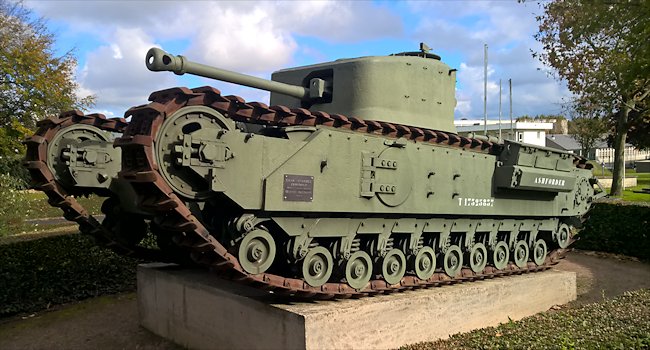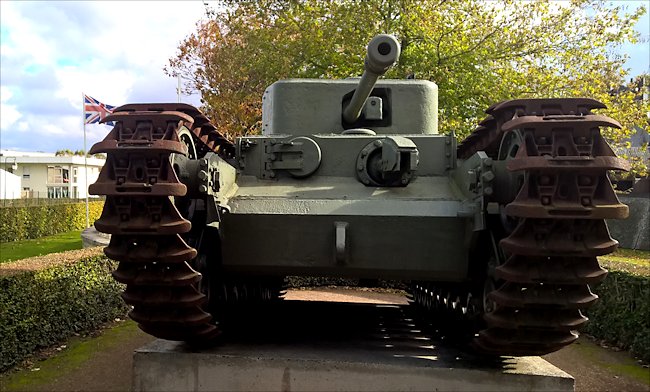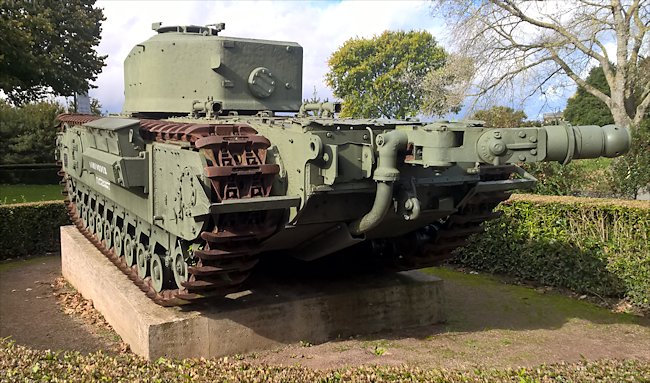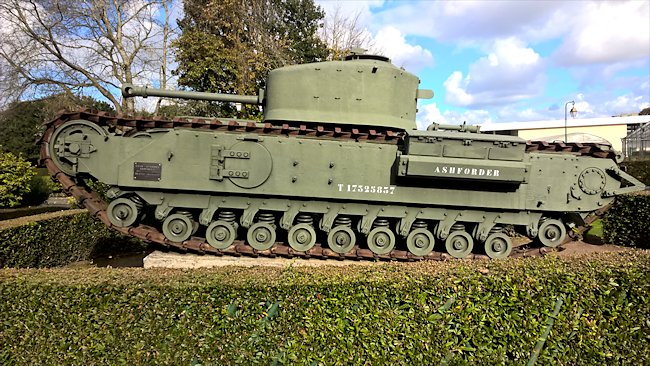Bayeux Churchill Mk VII Flamethrower Tank
This D-Day Churchill Mk VII Crocodile Flamethrower tank is on display outside the Battle of Normandy Memorial Museum in Bayeux along with a M10 Wolverine tank destroyer, Sherman tank and German Hetzer tank destroyer. It is believed that this tank was rescued from Pounds Scrapyard in Portsmouth where it had gone to be cut up, after the war.

Churchill Mk VII Crocodile Flamethrower Tank Bayeux Battle of Normandy Museum
Location
The four tanks at the Bayeux Memorial Museum of the Battle of Normandy are exhibited outside the Museum near the car park. The British and Commonwealth Cemetery is on the other side of the road. It holds the graves of 4,000 men. Both the Military Cemetery and the Museum are on the road called Boulevard Fabian Ware in Bayeux.
This road is part of the ring road around Bayeux that was built by the British Royal Engineers in June to enable the troops, tanks and supply vehicles to get to the battlefront quickly and avoid having to struggle through the narrow streets of the city of Bayeux. Be aware that the museum closes for lunch. You can still see the tanks as they are outside even if the museum is closed.

Churchill Mk VII Crocodile Tank's hull machine gun has been replaced by the flamethrower nozzle.
Specification
Around 800 Churchill Crocodile flame throwing tanks were built. The flamethrower nozzle replaced the hull mounted BESA machine gun. The tank turret was still armed with a machine gun fixed next to the main gun. The flame jet had a range of 150 yards (137 m) and was fired in one second bursts
The tanks armour thickness ranged from 25 mm to 152 mm on the front. Its main gun was a British 75mm 17pdr. The Mk VII was two tonnes heavier than the the previous versions due to the extra armour added to the tank. It was also known as the 'heavy Churchill'. The Churchill tank was never a fast machine. Its Bedford twin-six petrol engine only produced 350 hp. It was very under powered. The additional weight meant that it only had a top road speed of around 12 mph.

This is the fuel nozzle at the Rear of the Crocodile tank that attached to the towed flamethrower fuel trailer
Deployment in Normandy 1944
Major Percy Hobart was not even in the regular British Army when war was declared. He was a bit of a maverick in his day and went against standard British Army tactical thinking. He upset some senior officers that still believed the next big war would be fought like WW1. He had been in charge of tank brigades in the 1930's and was retired due to his unconventional ideas of replacing man power and horses with war machines like tanks.
In the early part of the WWW2 Hobart was an officer in the Home Guard. In 1940 Sir Winston Churchill summoned him to Chequers, the country house retreat of the Prime Minister. He was redeployed and tasked with overseeing the development of armoured fighting vehicles that could provide a solution to particular battlefield engineering problems, These would be called Hobart's 'Funnies'. They included mine clearing flail tanks, bridge laying Churchill tanks, artificial road laying tanks, swimming DD tanks, and flame throwing tanks like the Churchill Mk VIII Crocodile tank on display outside the Musee de la Bataille de Normandie in Bayeux.

This Churchill Mk VII Flamethrower Tank is missing its long 'catwalk' track guard.
They were called 'crocodiles' because of the way the tank moved when the flame thrower 400 gallon fuel trailer was attached to the back of the vehicle. They seemed to waddle side to side very slowly just like a big crocodile on dry land. It was feared by the German troops. The mere sound of the Churchill tank jetting flame out of its hull nozzle was enough sometimes to get the occupants of a gun emplacement or fortified house to surrender.
It was a vision from hell. Liquid flame coming at you at great speed looked like something from hell. Being burnt alive was a horrible painful way to die. Use of the flame thrower has always been controversial but this this tank saved allied lives by neutralising enemy machine gun strongpoints that would have cost many infantry lives to achieve the same objective.
This Churchill Mk VII Flamethrower Tank is missing its long 'catwalk' track guard. Its 75mm gun barrel shows evidence of having been cut in half, and not accurately rejoined. The tank was manufactured in September 1943. It was recovered from the compound of Pounds Shipowners and Shipbreakers Limited at Tipnor, Portsmouth, then cleaned and stripped of its badly rusted track guards and stowage boxes. It was transferred through Major General Brown of the Dulverton Trust. It was presented by Prime Minister Margaret Thatcher on behalf of the British Nation to the inhabitants of Normandy in commemoration of the Franco-British co-operation during the liberation of France in 1944.
Churchill Tank Variants
Churchill I: Original production model, 1941. Cast turret with 2pdr gun and co-axial 7-92 cal Besa MG. 3in howitzer mounted in nose. 150 rounds of 2pdr, and 58 rounds 3in ammunition. Some Churchill Is were used in the Dieppe raid, August 19, 1942.
Churchill IICS: As Churchill I but with gun positions changed so that 3in howitzer was in turret and 2pdr in nose. Built only in small numbers. All the above marks originally appeared with fully exposed tracks and engine intake louvres (on hull sides) which had side openings. From May 1942 a 'rework'" programme was started and most early vehicles were fitted with full track covers and had strengthening plates fitted in the front horns. In addition new air intake louvres were fitted which had the opening on the top to prevent engine flooding when wading. For deep wading, trunking could be fitted to the top of the air intakes. There were also, of course, mechanical improvements
Churchill II: As Churchill I but with 3in howitzer replaced by a second Besa MG.
Churchill III: Appearing in March 1942, this mark was the first to mount a 6pdr gun in line with War Office policy of upgunning cruiser and infantry tanks (further details included with A27 cruiser tank entry). To take the 6pdr gun a new welded turret was introduced which considerably altered external appearance. Early Mk Ills produced before May 1942 had the original type air intakes and lacked track covers. Many Mk Is and IIS were brought up to Mk Ill standard with new turret and gun.
Churchill IV: As Churchill Ill with 6pdr gun but with a new cast turret which offered armour protection slightly superior to the welded turret of the Mk Ill. First produced in mid 1942. Turrets apart, both the Churchill Ill and IV were identical. 84 rounds of 6pdr ammunition were carried. Most vehicles had the Mk 3 6pdr gun but some early production models had the Mk 5 6pdr, distinguished by its longer, lighter appearance and frequently seen with a counterweight on its muzzle.
Churchill IV (NA 75) : The appearance of the American M3 and M4 Medium tanks in the desert emphasised the need for guns of 75mm calibre in British tanks with a dual purpose HE/AP capability. The workshops of the brigades equipped with Churchills in 1 st Army in Tunisia in January 1943 acted on their own initiative and fitted 120 of their Mk IVs with complete M3 75mm guns and mantlets salvaged from wrecked Sherman tanks. These were the first Churchills (or indeed British tanks) to take guns of this calibre into action when the NA 75s were used with great success in the Sicily and Italian campaigns, remaining in service until 1945. In this form, 84 rounds of 75mm ammunition were carried. (NA: North Africa).
Churchill V: Produced concurrently with the Churchill IV this was the same basic vehicle fitted with a 95mm howitzer in place of the 6pdr, for the close support role. Only 10% of Churchill output had the 95mm howitzer (including the Mk V III—see below). 47 howitzer rounds were carried.
Churchill VI: Experience in the desert fighting led to demands from tank men for a 75mm gun in British tanks comparable to the 75mm guns fitted in the American M3 and M4 Mediums which had proved so successful in 8th Army hands. A British version of the 75mm gun, able to fire American ammunition, was developed by Vickers (for fuller details see A27 Cromwell entry) and plans were put in hand in January 1943 to mount this in the Churchill. The 75mm gun was not available until the winter of 1943-44 and a new mark of Churchill was meanwhile designed specially to mount it, the Mk V Il (see below). At the same time, from November 1943 onwards, existing Mk IVs were converted to roughly Mk V Il standards by the addition of a cupola, vane sights, and the 75mm gun in place of the 6pdr. With the Mk V Il, the converted vehicles, designated Mk VI, were used in NW Europe, 1944-45.
Gun Carrier, 3in, Mk I, Churchill: In September 1941, the General staff asked the Tank Board to investigate the possibility of producing cruiser and infantry tanks mounting large calibre high velocity guns specifically for engaging the largest German tanks. To fulfil the the cruiser tank requirement the Challenger (qv) was subsequently developed with the 17pdr gun. For the infantry tank requirement it was proposed to fit a 3in AA gun in a limited traverse mount on a churchill chassis. These weapons were available having been replaced in AA units by the 3.7in gun. A hundred vehicles were provisionally envisaged, but in December 1941 it was decided that all Churchill production would be needed for gun tanks, fitted with the 6pdr then just available. The order was thus reduced to 24 vehicles only. The pilot model was produced in February 1942 but these vehicles were never used operationally. Most were converted to carry Snake mine-clearing equipment and used for trials and training with this in 1943-44. Designated A22D.
Churchill VII: This was a largely redesigned version of the Churchill with thicker integral armour (as opposed to the composite construction on earlier Churchills), a new cast/welded heavy turret with cupola, circular (instead of square) escape doors, heavier suspension, improved gearbox, the 75mm gun, and many other refinements. Designated A22F, it was used in the NW Europe campaign 1944-45, and for many years post-war. 84 rounds of ammunition were carried. In 1945 this vehicle was re-designated A42.
Churchill VIII: As Churchill VII but with 95mm howitzer replacing the 75mm gun (see also Mk V, above).
Churchill IX: This was the Churchill Ill or IV re-worked to improved standards by fitting the same cast/welded heavy turret as the Mk V Il but retaining the 6pdr gun. Other improvements were the addition of appliqué armour on sides and front of the hull.
Churchill IX LT : Reworked Churchill Ill or IV as above but retaining the original turret (LT : Light Turret).
Churchill X: Mk VI reworked as Mk IX, but armed with the 75mm gun.
Churchill X LT: Reworked Mk VI retaining its original turret.
Churchill XI: Mk V reworked with heavy turret (as on Mk V III), plus applique armour
Churchill XI LT: Mk V reworked as for Mk XI, but retaining its original turret.
Churchill Oke : This was a flame-thrower tank developed by the Petroleum Warfare Dept very quickly in 1942 so that the idea of a flame-throwing vehicle could be tested under combat conditions in the Dieppe landing, August 1942. Basically a Churchill II, it had a complete Ronson flame- throwing system installed (which had been developed for use in the Universal Carrier). The flame fuel containers were mounted at the rear, and the pipe was passed through the left pannier to project between the front horns. Three vehicles took part in the Dieppe landing, but all were destroyed before they could be used. Range of the Oke was 40—50 yards.
Churchill Crocodile: After trials with flame fuel carried in trailers and tested on Valentines (qv) in 1942, the General Staff decided to standardise on a flame-throwing system actuated by gas (nitrogen) pressure. Design was finalised in 1943 with an initial order for 250 units featuring armour protection for the fuel trailer, and the Churchill IV was selected as operating vehicle.
In October 1943 the Mk VII was chosen instead. Fuel passed along the belly via a 'link' with the trailer, and the projector replaced the hull machine gun. Late production Churchill V IIS were all built for speedy adaptation to the Crocodile role as required. Vehicle's main armament could still be used, of course. Range of the Crocodile was 80—120 yards in 80 one-second bursts from a full trailer. When empty or hit the trailer could be jettisoned. Trailer weighed (long) tons. Used in NW Europe 1944-45, total production was 800 Crocodile units by May 1945, 250 earmarked for the Far East.
Churchill AVRE: (AVRE: Armoured Vehicle, Royal Engineers) Though the Dieppe raid was unsuccessful it proved that specialised types of armour were needed to assist assault forces in landing on and taking fortified open beaches. Urgently shown to be necessary was a heavily armoured vehicle to carry and support assault engineers charged with breaching heavy defences. Lt. Donovan of the Royal Canadian Engineers proposed adapting an existing tank. Both the Ram and Sherman were evaluated for the role, but the choice fell on the Churchill which had a roomier hull plus side escape doors which were useful for egress under fire.
A spigot mortar, called a Petard, of 290mm calibre and firing a 401b bomb 80 yards, was developed, tested in a Covenanter tank, and modified for fitting on the 6pdr mount of the Churchill Ill or IV. 180 Churchills of these marks were converted to AVREs by D-Day, June 6, 1944, and equipped the 1st Assault Brigade of 79th Armoured Division at this time. Subsequently another 574 vehicles were converted and AVREs played an important part in the NW Europe campaign.
AVREs were fitted to carry and drop fascines (brushwood bundles), the CIRD (Canadian Indestructible Roller Device) for mine-clearing, and SBG (Small Box Girder) bridges, attachment points being incorporated for all these to be handled as required. A few AVREs were unarmed or lacked the usual A VRE fittings, these being used mainly for training. Also produced for use the AVRE was a sledge for towing stores, fascines, or explosives.
D-Day 1944 books

